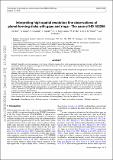Files in this item
Interpreting high spatial resolution line observations of planet-forming disks with gaps and rings : the case of HD 163296
Item metadata
| dc.contributor.author | Rab, Ch. | |
| dc.contributor.author | Kamp, I. | |
| dc.contributor.author | Dominik, C. | |
| dc.contributor.author | Ginski, C. | |
| dc.contributor.author | Muro-Arena, G. A. | |
| dc.contributor.author | Thi, W. -F. | |
| dc.contributor.author | Waters, L. B. F. M. | |
| dc.contributor.author | Woitke, P. | |
| dc.date.accessioned | 2020-11-10T17:30:14Z | |
| dc.date.available | 2020-11-10T17:30:14Z | |
| dc.date.issued | 2020-10-15 | |
| dc.identifier | 271171568 | |
| dc.identifier | 25b9a6e9-1fb8-4837-89be-845dc0eabd05 | |
| dc.identifier | 000581917300002 | |
| dc.identifier | 85093961049 | |
| dc.identifier.citation | Rab , C , Kamp , I , Dominik , C , Ginski , C , Muro-Arena , G A , Thi , W -F , Waters , L B F M & Woitke , P 2020 , ' Interpreting high spatial resolution line observations of planet-forming disks with gaps and rings : the case of HD 163296 ' , Astronomy & Astrophysics , vol. 642 , 165 . https://doi.org/10.1051/0004-6361/202038712 | en |
| dc.identifier.issn | 0004-6361 | |
| dc.identifier.uri | https://hdl.handle.net/10023/20943 | |
| dc.description | Funding: C. R., G. M.-A., and C. G. acknowledge funding from the Netherlands Organisation for Scientific Research (NWO) TOP-1 grant as part of the research programme “Herbig Ae/Be stars, Rosetta stones for understanding the formation of planetary systems”, project number 614.001.552. | en |
| dc.description.abstract | Context. Spatially resolved continuum observations of planet-forming disks show prominent ring and gap structures in their dust distribution. However, the picture from gas observations is much less clear and constraints on the radial gas density structure (i.e. gas gaps) remain rare and uncertain. Aims. We want to investigate the importance of thermo-chemical processes for the interpretation of high-spatial-resolution gas observations of planet-forming disks and their impact on the derived gas properties. Methods. We applied the radiation thermo-chemical disk code PRODIMO (PROtoplanetary DIsk MOdel) to model the dust and gas disk of HD 163296 self-consistently, using the DSHARP (Disk Substructure at High Angular Resolution) gas and dust observations. With this model we investigated the impact of dust gaps and gas gaps on the observables and the derived gas properties, considering chemistry, and heating and cooling processes. Results. We find distinct peaks in the radial line intensity profiles of the CO line data of HD 163296 at the location of the dust gaps. Our model indicates that those peaks are not only a consequence of a gas temperature increase within the gaps but are mainly caused by the absorption of line emission from the back side of the disk by the dust rings. For two of the three prominent dust gaps in HD 163296, we find that thermo-chemical effects are negligible for deriving density gradients via measurements of the rotation velocity. However, for the gap with the highest dust depletion, the temperature gradient can be dominant and needs to be considered to derive accurate gas density profiles. Conclusions. Self-consistent gas and dust thermo-chemical modelling in combination with high-quality observations of multiple molecules are necessary to accurately derive gas gap depths and shapes. This is crucial to determine the origin of gaps and rings in planet-forming disks and to improve the mass estimates of forming planets if they are the cause of the gap. | |
| dc.format.extent | 17 | |
| dc.format.extent | 3049500 | |
| dc.language.iso | eng | |
| dc.relation.ispartof | Astronomy & Astrophysics | en |
| dc.subject | Protoplanetary disks | en |
| dc.subject | Radiative transfer | en |
| dc.subject | Planets and satellites: formation | en |
| dc.subject | Astrochemistry | en |
| dc.subject | Methods: numerical | en |
| dc.subject | QB Astronomy | en |
| dc.subject | QC Physics | en |
| dc.subject | 3rd-DAS | en |
| dc.subject.lcc | QB | en |
| dc.subject.lcc | QC | en |
| dc.title | Interpreting high spatial resolution line observations of planet-forming disks with gaps and rings : the case of HD 163296 | en |
| dc.type | Journal article | en |
| dc.contributor.institution | University of St Andrews. School of Physics and Astronomy | en |
| dc.contributor.institution | University of St Andrews. St Andrews Centre for Exoplanet Science | en |
| dc.identifier.doi | https://doi.org/10.1051/0004-6361/202038712 | |
| dc.description.status | Peer reviewed | en |
| dc.identifier.url | https://arxiv.org/abs/2008.05941v1 | en |
This item appears in the following Collection(s)
Items in the St Andrews Research Repository are protected by copyright, with all rights reserved, unless otherwise indicated.

